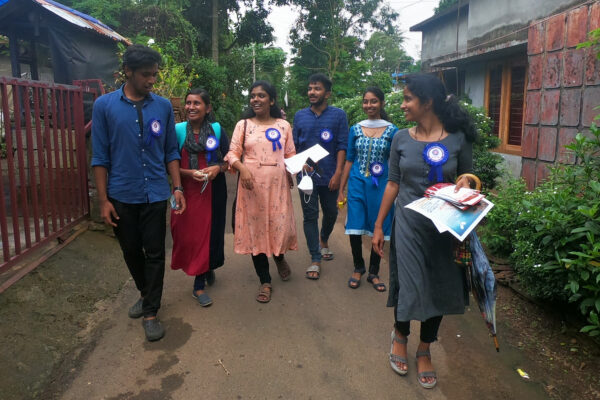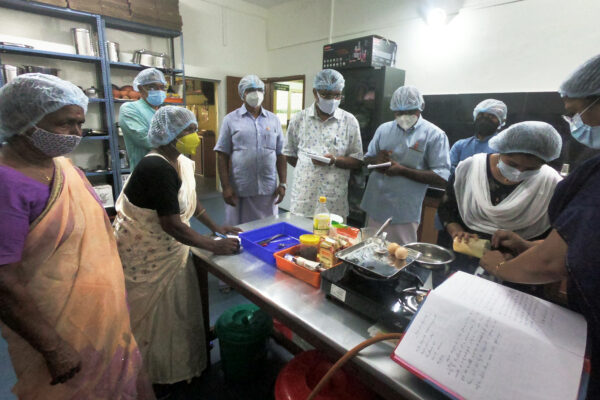2022-11-14
Can there be such a thing as an antibiotic smart community? If so, how could processes towards this be initiated and systematically approached? These questions, and an urging feeling that to be able to implement the National Action Plans on Antimicrobial Resistance there is a need for a bottom-up engagement approach. Communities need to engage for action on the global health challenge we all are facing - drug-resistant bacteria. With this mindset, ReAct Asia Pacific initiated the project Antibiotic Smart Communities.

The need for a bottom-up engagement in NAP implementation
The Antibiotic Smart Communities project of ReAct Asia Pacific came out of a realisation that the implementation efforts around the Global Action Plan on Antimicrobial Resistance (AMR) and National Action Plans on AMR were mostly top-down in character.
Many policies and interventions were planned at high-level meetings – and very little involvement of the target stakeholder groups and communities in the design of the initiatives. Additionally, there was very little resource mobilization happening at the grassroots level and poor local ownership.
Robust community engagement as a way forward

Therefore, ReAct Asia Pacific hypothesized that implementation of National Action Plans on AMR will increase if there is robust community engagement at least during the operationalization phase. The need for engaging communities and stakeholder groups has also been mentioned in the report of the Interagency Coordination Group on AMR (IACG-AMR).
“ReAct Asia Pacific has been working with us for raising awareness and empowering community groups on antibiotic resistance in Mallappuzhasserry Panchayat, since 2018.
The work involved partnership with several others like the Panchayat (local self-government institution), women’s self-help groups, local non-governmental organizations and religious organizations.
ReAct’s work could generate a lot of community assets and resources, besides improving the community ownership of these activities.”
Dr Mathew Koshy Punnakkad, Director, CSI Community Health Project
(one of the major partners in implementing the project in a small community in the state of Kerala, India)
Few models at hand – need to explore best practices
However the challenge has been that there were very few models for engaging local communities on a seemingly distant and silent issue like antimicrobial resistance.
Local governance structures, especially in low- and middle-income country contexts, may not prioritize antimicrobial resistance due to competing and more visible priorities.
Therefore, the Antibiotic Smart Communities project was meant to create a template for community engagement on the issue and explore best practices so as to increase the local ownership of interventions on antimicrobial resistance. Additionally, there was a want to design a holistic indicator framework to measure the level of preparedness of local communities to address the global health issue of drug-resistant bacteria.
Engaging a rural community in India
ReAct Asia Pacific initiated the Antibiotic Smart Community Project for concrete action on drug-resistant bacteria. It was launched in 2018. Video: ReAct Asia Pacific.
The Antibiotic Smart Community Project was launched in 2018 in a small rural community in the state of Kerala, India. The initial steps were:
- A preliminary sensitization meetings with community leaders.
- Subsequently, a Geographical Information System (GIS) mapping of non-domestic antibiotic use sites was done.
- A community survey was undertaken using a local language translation of the Eurobarometer 445 tool, to assess the level of awareness in the community.
- The following year the project had a round of focus group discussions to map the perceptions of various community stakeholder groups on health, disease, infections and antimicrobial resistance.
- A comprehensive situational analysis was undertaken to anchor our work with the local community. To gain access and build confidence, we used a healthcare delivery project managed by a local medical school and a community organisation for piggybacking.
Besides the planned community engagement activities, ReAct Asia Pacific used other opportunities that came its way. For example, a local folk music troupe was used to perform songs on health & hygiene during community events.
During the early phase of COVID-19 when there was severe shortage of medical masks, ReAct Asia Pacific facilitated local stitching and distribution of double layer cloth masks. During the time of the prolonged lockdown, the node also distributed vegetable seeds to more than 500 households, to help them develop “kitchen gardens” and understand locally-produced food as an alternative to agricultural intensification.
Designing and piloting the indicator framework
In 2019, ReAct Asia Pacific started the work on designing an indicator framework for measuring “antibiotic smartness” of local communities in low-and middle-income country settings. Consultation meetings were held with:
- public health,
- animal health and
- environment/development experts
to identify the domains to be included in the indicator framework.
List of 34 indicators
Based on the insights gathered through the community engagement exercise and feedback from the experts, a draft list of 34 indicators (along with methodology to measure and categorize) was prepared.
20 experts reduced indicators to 15
This list was presented to 20 selected experts with global experience on designing AMR-specific interventions. The experts used a well-defined process to prioritize the indicators and the number of indicators was reduced to 15. The indicators covered:
- human health,
- animal health,
- environment,
- water, sanitation & hygiene (WASH) and
- background socio-economic development of the community.
“We could apply the indicator framework in our community, with very minimal training delivered online over a week.
Most of the indicators are easily observable and do not require an intensive data collection process.
This framework can also be used as a situational analysis tool for understanding the deficiencies of the community in implementing projects aimed at strengthening systemic capacities”
Mr Sumit Kalkho, Research Coordinator, Duncan Hospital, Raxaul, Bihar state of India
(one of the places where the indicator framework was applied)
Indicators piloted in 5 communities

The indicators was piloted in the community that the ReAct Asia Pacific node were working – to assess the ease of application and quality of data collected. It was also applied in four other communities in other states in India – to assess the validity in diverse socio-cultural contexts.
After this ReAct Asia Pacific framed an action agenda for the community that the project were engaging in the state of Kerala, this based on the scores obtained through the piloting process.
The action agenda consisted of 12 specific activities, delivered over a period of 6 months with full community ownership, to improve the scores.
Training in the community followed

The activities and programs included innovative ones such as training the local school children on soap-making, demonstrating compost/soakage pit construction, and sensitization of AMR-issues to retail pharmacies.

When the indicator framework was reapplied at the end of six months, we found a significant increase in scores showing that the framework is sensitive to changes.
2 challenges the project faced
1, Community engagement is a resource-intensive exercise
Especially when we are working to elevate a “silent” issue like antimicrobial resistance. Therefore, defining the contours and end-points for our engagement was a challenge. Communication challenges were always present during the implementation phase of the project. There were no appropriate words in the local language for many AMR-related terminologies and each community stakeholder group required different messaging frames and channels. We overcame this challenge by translating the AMR dictionary to Malayalam (the local language) and also creating a strategy document to guide messaging for various stakeholder groups.
2, When applying the indicator framework, ReAct Asia Pacific faced challenges in obtaining prescriptions
This from private medical practitioners and details of antibiotic dispensing by private retail pharmacies. This was overcome by co-opting the local self-government institutions into the process.
3 lessons learned from the project
1, Engaging community stakeholder groups and local governance structures are vital in improving the ownership and sustainability of AMR interventions in local contexts.
However this requires a carefully iterated strategy based on local resource availability and the systemic capacity to take up the interventions. A “one-size-fits-all” approach may not work because of the vast differences in socio-cultural, demographic and economic conditions.
2, Translating and de-jargonizing antimicrobial resistance is the first step in engaging local communities.
The level of awareness about antimicrobial resistance is low and it is still perceived as a medical issue by most community stakeholder groups. The multi-sectoral nature of the drivers and impact of antimicrobial resistance are often not understood; and is a barrier which prevents communities from prioritizing this issue.
3, Creating allies and champions could be the best way to increase the impact of community engagement exercises.
We should be able to encourage various community organisations to apply an AMR-lens in their work. The social capital available for more visible issues such as climate change or nutrition, should be tapped into by demonstrating their linkages with antimicrobial resistance.
More from "2022"
- 15 things that need to happen in 2023 – for a robust response on antibiotic resistance!
- 7.7 million people die from bacterial infections every year
- ReAct highlights during World Antimicrobial Awareness Week 2022
- Awareness walk in Lusaka, Zambia
- ReAct Asia Pacific: Competitions, webinars, social media campaigns and new Indonesian declaration on AMR
- Otto Cars awarded Research!Sweden’s Honorary Award
- Innovate4Health: 16 finalists from 12 countries!
- Otto Cars has dedicated his life to the fight against antibiotic resistance
- ReAct activities for World Antimicrobial Awareness Week 2022
- ReAct Asia Pacific: Antibiotic Smart Communities as a way forward
- Webinar ReAct Asia Pacific! Moving towards an Antibiotic Smart Community – the use of a novel indicator framework
- Join ReAct Latin America Meeting: Empowered Communities!
- The impact of antibiotic resistance on cancer treatment, especially in low-and middle-income countries, and the way forward
- Sweden: Pernilla’s 8-day old daughter died from sepsis – caused by resistant bacteria Klebsiella
- Five challenges that governments need to address in resolving the stagnation in antibiotic development
- The monkeypox outbreak: Need for antibiotic stewardship?
- Key takeaways from the ReAct Africa and South Centre Conference
- New ReAct Europe and EPHA position paper on EU incentives for new antibiotics development
- Launch of a new approach to antimicrobial stewardship in Zambia
- Time to register for the annual ReAct Africa and South Centre conference!
- Innovate4Health 2022: Call for student team applications!
- “Need to address the paradox of hospitals spreading disease” says new WHO report
- 5 takeaways from AMR Stockholm+50 event
- Student Tehseen Contractor
- ReAct Latin America: call to governments on the use of antimicrobials in intensive animal husbandry
- Join ReAct Stockholm+50 associated event! Global AMR response – What needs to be done?
- New opportunities for global action on AMR?
- Public hearings on elements to be included in a new international instrument on pandemic preparedness & response
- Policy briefing on WHO GAP AMR: 8 pillars of action to address global solutions to AMR
- India: State Action Plans on AMR in focus at stakeholder colloquium
- The silence is killing us – time to listen to the facts
- Access to clean water – a fairly inexpensive way to avoid infections
- Anna Sjöblom new Director ReAct Europe
- Dr. Hari Paraton: Drug resistance bacteria threatens lives of mothers and newborns
- Antibiotic resistance claims more than 1,2 million lives a year, says new large study
- Artificial intelligence – the future of antibiotic resistance prevention?
